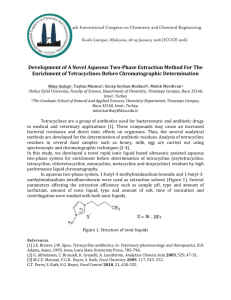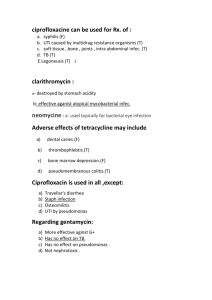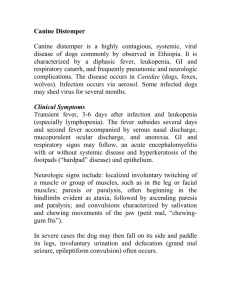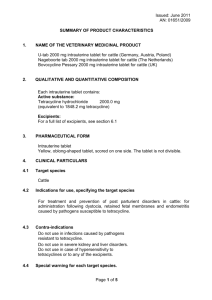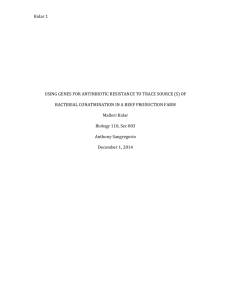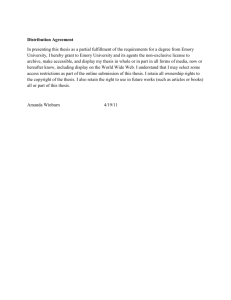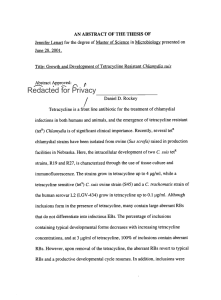moise (1) - Unitus DSpace
advertisement
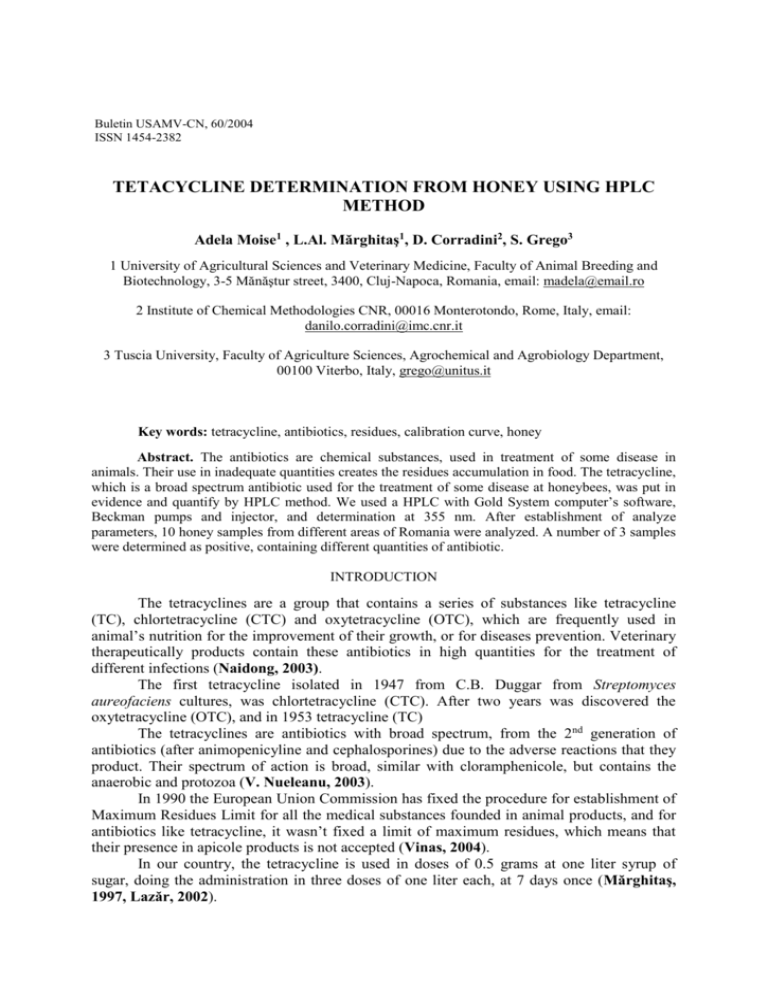
Buletin USAMV-CN, 60/2004 ISSN 1454-2382 TETACYCLINE DETERMINATION FROM HONEY USING HPLC METHOD Adela Moise1 , L.Al. Mărghitaş1, D. Corradini2, S. Grego3 1 University of Agricultural Sciences and Veterinary Medicine, Faculty of Animal Breeding and Biotechnology, 3-5 Mănăştur street, 3400, Cluj-Napoca, Romania, email: madela@email.ro 2 Institute of Chemical Methodologies CNR, 00016 Monterotondo, Rome, Italy, email: danilo.corradini@imc.cnr.it 3 Tuscia University, Faculty of Agriculture Sciences, Agrochemical and Agrobiology Department, 00100 Viterbo, Italy, grego@unitus.it Key words: tetracycline, antibiotics, residues, calibration curve, honey Abstract. The antibiotics are chemical substances, used in treatment of some disease in animals. Their use in inadequate quantities creates the residues accumulation in food. The tetracycline, which is a broad spectrum antibiotic used for the treatment of some disease at honeybees, was put in evidence and quantify by HPLC method. We used a HPLC with Gold System computer’s software, Beckman pumps and injector, and determination at 355 nm. After establishment of analyze parameters, 10 honey samples from different areas of Romania were analyzed. A number of 3 samples were determined as positive, containing different quantities of antibiotic. INTRODUCTION The tetracyclines are a group that contains a series of substances like tetracycline (TC), chlortetracycline (CTC) and oxytetracycline (OTC), which are frequently used in animal’s nutrition for the improvement of their growth, or for diseases prevention. Veterinary therapeutically products contain these antibiotics in high quantities for the treatment of different infections (Naidong, 2003). The first tetracycline isolated in 1947 from C.B. Duggar from Streptomyces aureofaciens cultures, was chlortetracycline (CTC). After two years was discovered the oxytetracycline (OTC), and in 1953 tetracycline (TC) The tetracyclines are antibiotics with broad spectrum, from the 2nd generation of antibiotics (after animopenicyline and cephalosporines) due to the adverse reactions that they product. Their spectrum of action is broad, similar with cloramphenicole, but contains the anaerobic and protozoa (V. Nueleanu, 2003). In 1990 the European Union Commission has fixed the procedure for establishment of Maximum Residues Limit for all the medical substances founded in animal products, and for antibiotics like tetracycline, it wasn’t fixed a limit of maximum residues, which means that their presence in apicole products is not accepted (Vinas, 2004). In our country, the tetracycline is used in doses of 0.5 grams at one liter syrup of sugar, doing the administration in three doses of one liter each, at 7 days once (Mărghitaş, 1997, Lazăr, 2002). The dust of tetracycline is mixed with powder sugar in quantity of 5 grams at 1 kilogram of sugar and is administrated by sprinkle in three doses of 100 grams each, once at 7 days for the treatment of American Foulbroad; for the treatment of European Foulbroad 0.50.75 grams are dissolved in one liter syrup and are administrated 250-500ml, function of the power of bees family and the seriousness of disease; 4-5 administrations are recommended at 4-5 days (Mărghitaş, 2002). MATERIAL AND METHOD Our experimental determinations were developed at the University of Agriculture Science from Viterbo, Italy, on 10 samples of honey. The samples were collected from different areas of Transylvania, and from different producers. The standard tetracycline Hydrate (C22H24N2O8) was produced by ALDRICH®, having the purity 99%, molecular weight 444.44, yellow color. The chemical substances used are deionisated water, acetonitrile, acetate (99%), triethylamine (TEA). The HPLC system that was used contains: 1. Two BECKMAN® pumps, working in gradient, each pump taking just one mobile phase, at an established pressure of 1ml/min. 2. One injector BECKMAN® 340Organizer, which has two positions for making the injection. For the sample insertion in the system’s lump was used a Hamilton injection, whit the volume 100 µl. 3. The column, positioned immediately after the injector, was produced by ALTECH® and named Hipersil ODS (C18) 5u, 150 mm long, whit ID 4.6mm;the column equilibration checking was made with a gradient of 60% (v/v) CH3CN and 40% (v/v) H2O, at a flow rate 1.0 ml/min. 4. The detector, produced by BECKMAN®, is adaptable at different wavelengths. To evidence the tetracycline, the detector was fixed at 355 nm. The recorded signals by the detector are transmitted to one modular interphase system (BECKMAN COULTER®), adapted to the Gilson System- the operation system of the computer. To establishing the calibration curve of tetracycline, different concentrations of standard tetracycline (0.2; 0.16; 0.12 and 0.08 mg/ml H2O), were prepared. The standards were injected in HPLC, and the peaks obtained are presented in figure 1, 2, 3 and 4. The retention times and the peaks areas are presented in Table 1. The calibration curve of tetracycline (Fig.5) was obtained using the peak’s areas, described by the equation y = 1E+07X. The same formula was used for the recalculation of concentration of antibiotics in honey samples. Fig.1 – Tetracycline standard 0.20 mg/ ml H2O (355 nm) Fig. 3– Tetracycline standard 0.12 mg/ ml H2O (355 nm) Fig.2 – Tetracycline standard 0.16 mg/ ml H2O (355 nm) Fig. 4– Tetracycline standard 0.08 mg/ ml H2O (355 nm) Table 1 Figure 1 2 3 4 Concentration of standard solution (mg/ ml H2O) 0.20 0.16 0.12 0.08 Retention time Peak area 6.01 5.70 5.90 6.07 2392774.00 1955688.75 1496487.38 902642.81 3000000 2500000 y = 1E+07x R2 = 0.9979 area 2000000 1500000 1000000 500000 0 0 0.05 0.1 0.15 0.2 0.25 con Fig.5 – Calibration curve, obtained after injection of tetracycline standard A quantity of 9 grams of honey was used in order to perform extraction. It was mixed with 18 ml McIlvaine buffer (pH 4.5), centrifuged for 10 minutes (2 500 rot/min), vaporized 15 minutes until the volume is 8 ml, and after that the volume is fixed at 10 ml with McIlvaine buffer, to be ready for injection. Each injection had 100µl volume. A gradient of 10-52% CH3CN (12 minutes), 52-100% CH3CN (2 minutes), 100% CH3CN (5 minutes), and 100-10% CH3CN (1 minute) was used in this study. After the gradient is finished the column equilibration is made with running of 10% CH3CN for 20 minutes. The mobile phases used were CH3CN and CH3COOH (40 mM), at the pH 4.0, fixed with triethylamine. RESULTS AND DISCUSSIONS After application of the described methodology 3 positive samples were obtained. The chromatograms of the samples that are founded positive are presented in the Figure 6, 7,and 8, and the retention times and the peak’s areas are presented in table 2. Fig.6 – Sample no 1 (355 nm) Fig. 7 – Sample no 2 (355 nm) Fig.8 – Sample no 3 (355 nm) The quantities of tetracycline in tested samples were calculated taking into account the peak area and the equation that describes the calibration curve. Table 2 Peaks area and the retention time of three samples of honey, and the quantities of tetracycline from the honey sample Number of sample 1 2 3 Retention time Peaks area 5.39 6.31 6.35 27798.37 25253.34 26296.67 Quantities obtained (mg/ml) 0.0023 0.0020 0.0021 CONCLUSIONS 1. From 10 analyzed samples from different areas of Transylvania, 3 were identified as positive, different quantities of antibiotic being also determined. Function of retention time and peak areas, the tetracycline quantities determined in honey range between 0.0021 and 0.0023 mg/ml. 2. The use of HPLC method in order to determine tetracycline residues in honey proved high sensibility, being adequate to determine the presence of very low concentrations in analyzed samples. 3. The presence of tetracycline residues in honey show the inadequate quantities administered in bees. This determines the alteration of honey quality, which become not correspondent to UE norms. BIBLIOGRAPHY 1. 2. 3. 4. 5. 6. Lazar, S., (2002) – Bioecologie si tehnologie apicola, Ed. ALFA, Iasi Marghitas, L. Al., (1997) – Albinele si produsele lor, Ed. Ceres, Bucuresti Marghitas, L. Al., (2002) – Albinele si produsele lor, editia a II-a, Ed. Ceres, Bucuresti Naidong, W., Sun Hua, E. Roets, J. Hoogmartens (2003) – Assay and purity control of tetracycline, chlortetracycline and oxytetracycline in animal feeds and premixes by TLC densiometry with fluorescence detection, Journal of Pharmaceutical and Biomedical Analysis 33, p. 85-93 Nueleanu, Venturia (2003)- Farmacologie veterinara, Ed. AcademicPres, Cluj-Napoca Vinas, P., N. Balsalobre, Carmen Lopez-Erroz, M. Hernandez-Cordoba (2004) – Liquid chromatography with ultraviolet absorbance detection for the analysis of tetracycline residues in honey, Journal of Chromatography A, 1022, p. 125-129 Acknowledgements This work was developed with the support of Tuscia University- Viterbo, Italy, and CNRMonterotondo, Italy
